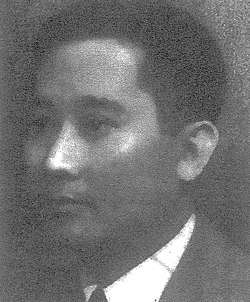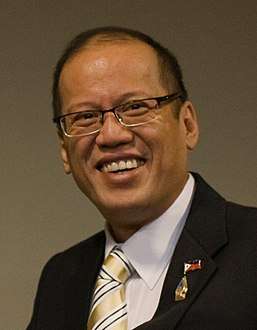Benigno Aquino Sr.
Benigno Simeon "Igno" Aquino Sr.[1][2][3][4] (September 3, 1894 – December 20, 1947), also known as Benigno S. Aquino or Benigno S. Aquino Sr., was a Filipino politician who served as Speaker of the National Assembly of the Japanese-sponsored puppet state in the Philippines from 1943 to 1944.
The Honorable Benigno S. Aquino Sr. | |
|---|---|
 | |
| 6th Speaker of the House of Representatives of the Philippines 1st Speaker of the National Assembly of the Second Philippine Republic | |
| In office September 25, 1943 – February 2, 1944 | |
| President | José P. Laurel |
| Preceded by | José Yulo |
| Succeeded by | Jose Zulueta |
| Member of the National Assembly of the Second Philippine Republic from Tarlac | |
| In office September 25, 1943 – February 2, 1944 Serving with Sergio L. Aquino | |
| Secretary of Agriculture and Commerce of the Philippines | |
| In office 1938–1941 | |
| President | Manuel L. Quezon |
| Preceded by | Eulogio Rodriguez |
| Succeeded by | Rafael Alunan |
| Member of the National Assembly of the Philippines from Tarlac's 2nd District | |
| In office December 30, 1941 – December 30, 1944* *Elected but did not serve term due to the establishment of the Second Philippine Republic | |
| Preceded by | Jose Urquico |
| Succeeded by | Alejandro Simpaoco as member of the 1st Congress of the Commonwealth of the Philippines |
| In office December 30, 1935 – December 30, 1938 | |
| Preceded by | Feliciano B. Gardiner as member of the 10th Philippine Legislature |
| Succeeded by | Jose Urquico |
| Majority Leader of the Philippine Senate | |
| In office 1931–1934 | |
| Senate President | Manuel L. Quezon |
| Preceded by | José P. Laurel |
| Succeeded by | Claro M. Recto |
| Philippine Senator from the 3rd Senatorial District | |
| In office 1928 – 1934 Served with: Teodoro Sandiko (1928–1931) Sotero Baluyot (1931–1934) | |
| Preceded by | Luis Morales |
| Succeeded by | Hermogenes Concepcion |
| Member of the Philippine House of Representatives from Tarlac's 2nd District | |
| In office 1919–1928 | |
| Preceded by | Cayetano Rivera |
| Succeeded by | Jose G. Domingo |
| Vice President of the Philippines | |
| In office October 14, 1943 – August 17, 1945 | |
| Preceded by | Sergio Osmeña |
| Succeeded by | Elpidio Quirino |
| Personal details | |
| Born | Benigno Simeon Aquino September 3, 1894 Murcia (now Concepcion), Tarlac, Captaincy General of the Philippines |
| Died | December 20, 1947 (aged 53) Rizal Memorial Coliseum, Manila, Philippines |
| Cause of death | Heart attack |
| Nationality | Filipino |
| Political party | Partido Nacionalista Consolidato, KALIBAPI |
| Spouse(s) | Maria Urquico
( m. 1916; died 1928)Aurora Aquino
( m. 1930; |
| Relations | Aquino family |
| Children | 11 (incl. Benigno Jr., Butz and Tessie) |
| Alma mater | University of Santo Tomas Colegio de San Juan de Letran |
| Occupation | Farmer, politician |
| Profession | Lawyer, civil servant |
He was the Director-General of KALIBAPI, a political party established during the Japanese occupation of the Philippines.
His grandson Benigno S. Aquino III was the 15th President of the Philippines from 2010 to 2016.
Early life
Benigno "Igno" Aquino was born in Murcia, now part of Concepcion, Tarlac, to Servillano "Mianong" Aquino, a general in the Philippine Revolution who later served as a member of the Malolos Congress, and Guadalupe Quiambao. He had two siblings: Gonzalo Aquino (born 1893) and Amando Aquino (born 1896), and a half-brother, Herminio Aquino (born 1949). He studied at the Colegio de San Juan de Letran in Manila and later at the University of Santo Tomas, where he earned his law degree in 1913, and was admitted to the bar the following year.
Political career
Aquino was first elected to the Philippine Legislature (as a member of the Philippine House of Representatives) in 1919 representing the 2nd District of Tarlac. He was reelected to the same position in 1922 and 1925 before winning a Philippine Senate seat in 1928 representing the 3rd Senatorial District comprising the provinces of Bulacan, Nueva Ecija, Pampanga and his home-province of Tarlac. He became part of the Philippine Independence Mission in 1931, which negotiated the terms of obtaining Philippine independence from the United States. During the elections for the Commonwealth of the Philippines government in 1935 he ran again in his district in Tarlac and won. In 1937, he was appointed by Commonwealth President Manuel L. Quezon as Secretary of Agriculture and Commerce.
Speaker of the National Assembly
Being among the more prominent Commonwealth officials remaining in the country after the Commonwealth government went into exile in 1941, Aquino was among those recruited by the Japanese to form a government. He became the director-general of KALIBAPI and one of the two assistant chairmen of the Preparatory Commission for Philippine Independence. When the Second Philippine Republic was inaugurated, he was elected Speaker of the National Assembly.
Arrest and collaboration charges

In December 1944, as the combined Filipino and American forces continued their advance to liberate the Philippines from Japanese forces, the government of the Second Philippine Republic, which included Aquino, was moved to Baguio. Subsequently it was flown to Japan where, together with other officials, its members were arrested and imprisoned at the Sugamo Prison when the Japanese surrendered. On August 25, 1946, Aquino was flown back to the Philippines for his trial on treason charges by the People's Court; a few weeks later he was released on bail.
Personal life
First marriage
In May 1916, he married Maria Urquico, the daughter of katipunero Antonio Urquico and Justa Valeriano. He had two sons and two daughters with Maria: Antonio Aquino (1917–1993), Servillano Aquino II (1919–1973), Milagros Aquino (1924–2001), and Erlinda Aquino.
Second marriage
After Maria died in March 1928, he married Aurora Lampa Aquino (maiden name, granddaughter of Melencio Aquino and Evarista de los Santos[5] and daughter of Agapito de los Santos Aquino and Gerarda Miranda Lampa) on December 6, 1930, with whom he had seven children—Maria Aurora (Maur), Benigno Simeon Jr. (Ninoy), Maria Gerarda (Ditas), Maria Guadalupe (Lupita), Agapito (Butz), Paul, and Maria Teresa (Tessie).[6]
Death
On December 20, 1947, Aquino died of a heart attack at the Rizal Memorial Coliseum in Manila while watching a boxing match. His widow Aurora died in 1998.
Ancestry
| Ancestors of Benigno Aquino Sr. | ||||||||||||||||||||||||||||||||||||||||||||||||||||||||||||||||||||||||||||||||||||||||||||||||||||||||||||||||||||||||||||||||||||||||||||||||||||||||||||||||||||||||||||||||||||||||||||||||||||||||||||||||||||||||||||||||||||||||||||||||||||||||||||||||||||||||||||||||||||||||||||||||||||||||||||||||||||||||||||||||||||||||||||||||||||||||||||||||||||||||||||||||||||||||||||||||||||||||||||||||||||||||||||||||||||||||||||||||||||||||||||||||||||||||||||||||||||||||||||||||||||||||||||||||||||||||||||||||||||||||||||||||||||||||||||||||||||||||||||||||
|---|---|---|---|---|---|---|---|---|---|---|---|---|---|---|---|---|---|---|---|---|---|---|---|---|---|---|---|---|---|---|---|---|---|---|---|---|---|---|---|---|---|---|---|---|---|---|---|---|---|---|---|---|---|---|---|---|---|---|---|---|---|---|---|---|---|---|---|---|---|---|---|---|---|---|---|---|---|---|---|---|---|---|---|---|---|---|---|---|---|---|---|---|---|---|---|---|---|---|---|---|---|---|---|---|---|---|---|---|---|---|---|---|---|---|---|---|---|---|---|---|---|---|---|---|---|---|---|---|---|---|---|---|---|---|---|---|---|---|---|---|---|---|---|---|---|---|---|---|---|---|---|---|---|---|---|---|---|---|---|---|---|---|---|---|---|---|---|---|---|---|---|---|---|---|---|---|---|---|---|---|---|---|---|---|---|---|---|---|---|---|---|---|---|---|---|---|---|---|---|---|---|---|---|---|---|---|---|---|---|---|---|---|---|---|---|---|---|---|---|---|---|---|---|---|---|---|---|---|---|---|---|---|---|---|---|---|---|---|---|---|---|---|---|---|---|---|---|---|---|---|---|---|---|---|---|---|---|---|---|---|---|---|---|---|---|---|---|---|---|---|---|---|---|---|---|---|---|---|---|---|---|---|---|---|---|---|---|---|---|---|---|---|---|---|---|---|---|---|---|---|---|---|---|---|---|---|---|---|---|---|---|---|---|---|---|---|---|---|---|---|---|---|---|---|---|---|---|---|---|---|---|---|---|---|---|---|---|---|---|---|---|---|---|---|---|---|---|---|---|---|---|---|---|---|---|---|---|---|---|---|---|---|---|---|---|---|---|---|---|---|---|---|---|---|---|---|---|---|---|---|---|---|---|---|---|---|---|---|---|---|---|---|---|---|---|---|---|---|---|---|---|---|---|---|---|---|---|---|---|---|---|---|---|---|---|---|---|---|---|---|---|---|---|---|---|---|---|---|---|---|---|---|---|---|---|---|---|---|---|---|---|---|---|---|---|---|---|---|---|---|---|---|---|---|---|---|---|---|---|---|---|---|---|---|---|---|---|---|---|---|---|---|---|---|---|---|---|---|---|---|---|---|---|---|---|---|---|---|---|---|---|---|---|---|---|---|---|---|---|---|---|---|---|---|---|---|---|---|---|---|---|---|---|---|---|---|---|---|---|---|---|---|---|---|---|---|---|---|---|---|---|---|---|---|---|---|---|---|---|---|---|---|---|---|---|---|---|---|---|---|---|---|---|---|---|---|---|---|---|---|
| ||||||||||||||||||||||||||||||||||||||||||||||||||||||||||||||||||||||||||||||||||||||||||||||||||||||||||||||||||||||||||||||||||||||||||||||||||||||||||||||||||||||||||||||||||||||||||||||||||||||||||||||||||||||||||||||||||||||||||||||||||||||||||||||||||||||||||||||||||||||||||||||||||||||||||||||||||||||||||||||||||||||||||||||||||||||||||||||||||||||||||||||||||||||||||||||||||||||||||||||||||||||||||||||||||||||||||||||||||||||||||||||||||||||||||||||||||||||||||||||||||||||||||||||||||||||||||||||||||||||||||||||||||||||||||||||||||||||||||||||||
See also
- Second Philippine Republic
- National Assembly of the Second Philippine Republic
- Speaker of the House of Representatives of the Philippines
- Legislative districts of Tarlac
References
- Masterpieces in Philippine oratory, and lessons in public speaking (1938) Honorable BENIGNO S. AQUINO – Secretary of Agriculture and Commerce
- The Philippine Journal of Agriculture (1939) – Hon. BENIGNO S. AQUINO – Secretary of Agriculture and Commerce
- "I am the son of the late Benigno S. Aquino Sr, a former congressman, a senator, Cabinet member..." – Testament from a prison cell (1984) by Benigno S. Aquino Jr.
- Speech delivered by the honorable speaker Benigno S. Aquino, Director-General of the KALIBAPI on constitution day September 7, 1944
- https://www.familysearch.org/tree/pedigree/landscape/LCJ1-RWP
- "Views from the Pampang: The other Benigno".
External links
| Wikimedia Commons has media related to Benigno Aquino. |
- "Benigno Aquino Sr". Archived from the original on October 27, 2009. Retrieved 2010-10-08.CS1 maint: BOT: original-url status unknown (link) . Accessed on April 24, 2007.
- Allied Families: Aquino-Cojuangco. Accessed on April 25, 2007.
- Sugar and the Origins of Modern Philippine Society. Accessed on April 25, 2007.

